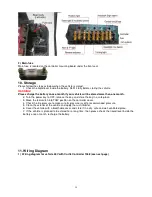
20
2,3
THERMAL
CUTBACK
Over-/under temperature. 1. Temperature > 85°C or < -25°.
2. Excessive load on vehicle.
3. Improper mounting of controller.
4. Operation in extreme environments.
2,4
MAIN DRIVER ON
Main contactor coil held
low.
1. Main contactor missing or wire to coil is
open.
2. Controller is defective.
2,5
AUX COIL FAULT
Missing aux (brake, relay)
coil.
1. Aux coil open or not connected.
3,1
MAIN DRIVER
OFF
Main contactor driver
held high.
1. Main contactor coil shorted.
2. Controller is defective.
3,2
MAIN WELDED
Main contactor welded.
1. Main contactor stuck closed.
2. Main contactor driver shorted
Troubleshooting Chart –
Cont’d
3,3
PRECHARGE
FAULT
Internal voltage too low at
startup.
1. External short, or leakage path to B- is on
external B+ connection.
2. Controller defective.
3,4
FIELD MISSING
Field winding fault.
1. Motor field wiring loose.
2. Motor field wiring open.
3,5
AUX DRIVER OFF
Aux (brake, relay) driver
held high.
1. Aux coil shorted.
2. Controller defective.
4,1
CURRENT SENSE
FAULT
Armature or field current
sensor fault.
1. Controller defective.
4,2
DRIVER
OVERCURRENT
Contactor driver or aux
driver overcurrent.
1. Contactor or aux coil shorted.
4,3
M- SHORTED
Internal M- short to B-.
1. Controller defective.
4,4
AUX RELAY DNC
Aux relay did not close.
1. Aux relay missing or wire to coil open.
4,5
WELDED AUX
RELAY
Welded aux relay.
1. Aux relay stuck closed.
2. Aux relay shorted.
5,1
KEY SWITCH SRO SRO fault.
1. Key switch not off at power-up.
2. Key switch shorted.
5,2
MAIN COIL OPEN
Missing the main contactor
1. Main contactor coil open or not
connected.
5,3
AUX DRIVER ON
Aux (EM brake or
WalkAway™ relay) driver
coil held low.
1. Aux output short to ground.
2. Controller defective.
5,4
CIRCUIT BRKR
OPEN
Circuit breaker or fuse open
in WalkAway™ circuit.
1. Breaker/fuse tripped or open.
2. Breaker/fuse defective.
3. Relay/fuse sense line broken.
5,5
MAIN DROPOUT
Main contactor open.
1. Main contactor defective.
A built-in Status LED is visible through a window in the label on top of the controller. When the controller
detects a fault, the Status LED flashes the 2-digit fault code. The code is flashed continuously until the fault
is corrected. For example, code “3, 2”—welded main contactor—appears as:
¤ ¤ ¤
¤ ¤ ¤ ¤ ¤ ¤ ¤ ¤ ¤ ¤ ¤ ¤
etc.
( 3 , 2 )
( 3 , 2 )
( 3 , 2 )
The codes are listed in the Troubleshooting Chart. Only one fault is indicated at a time, and faults are not
queued up. If multiple faults are active simultaneously, the code of the highest priority fault is flashed. After
all faults have been cleared, the code of the last active fault will continue to flash for one minute. This
feature is designed to help service personnel identify intermittent faults when no programmer is available.







































